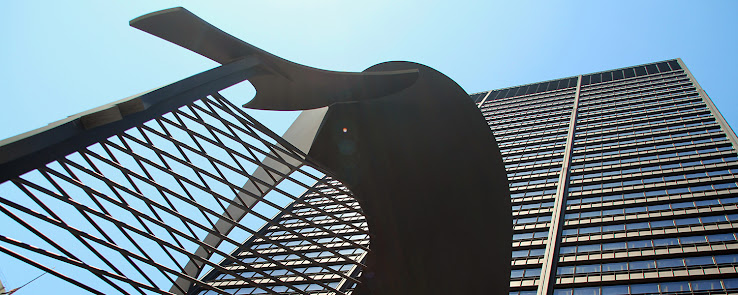 |
| Bowman - by Ivan Mestrovic |
The Bowman and The Spearman
Sculptor: Ivan Mestrovic
Installed: 1928
Description: Bronze figures / H 17 ft. (each)
Location: Congress Plaza Gardens
S. Michigan Ave. (100 E) & E. Congress Pkwy. (500 S)
Chicago, IL 60604
Commissioned by the B.F. Ferguson Monument Fund,
to commemorate Native Americans.
 |
| Bowman - by Ivan Mestrovic |
 |
| Spearman - by Ivan Mestrovic |
 |
| Bowman and Spearman - by Ivan Mestrovic |
Sculptor Ivan Mestrovic intended his monumental figures to commemorate the Native American and symbolize the struggle to settle this country. The figures are lean and muscular, tensed for the actions of hurling a spear and releasing an arrow. Mestrovic has heightened the forcefulness of these gestures by making viewers use their imaginations to supply the missing weapons. Although they are modeled in-the-round, the equestrians are viewed to their most monumental effect as relief silhouettes against the sky.
To create the bronze pair, trustees of the Art Institute of Chicago’s B.F. Ferguson Fund commissioned Ivan Mestrovic (1883-1962), an internationally-acclaimed sculptor from Croatia (then part of the Austro-Hungarian Empire). Mestrovic came to Chicago in 1926 when the Art Institute presented an exhibition of his work. Mestrovic cast the pieces in Yugoslavia, and said that though the horses represent those from his home more than the American prairie warriors’, they captured the vitality of Chicago. The equestrian figures are poised to shoot an arrow and throw a spear; however, neither holds a weapon. Although there is a long-held belief that the bow and spear were removed and never returned, this is an urban myth. The sculptor quite consciously omitted these items, leaving the weapons to the imagination of the viewers ..
Ivan Mestrovic [1883-1962] is a workd renowned sculptor. Though born in Croatia, he later took American citizenship. President Dwight D. Eisenhower had personally presided over the ceremony to grant Mestrovic the American citizenship in 1954!!! He was the first person to have a one man show at the Metropolitan Museum of Art in New York City.


For more on Grant Park ..
# Public Art in the Grant Park .. click here ....
# Gardens in the Grant Park .. click here ..
# Often overlooked but remarkable features like pedestrian crossings, the railway lines underneath, the street lamp posts, balustrade, corbels, the Y-symbols .. click here ..
# For a brief history of Grant Park .. click here ..

6 comments:
Ivan Mestrovic was born in Croatia 1883 (which was then part of the Austro Hungarian empire). His parents, grandparents and grand-grandparents were Coats and he always considered himself Croat (what else he can be?).
The citizenship is another thing.
He left Yugoslavia because he did not liked communism.
Yugoslavia was an artificial state which - mind you - did not exist prior to 1918, and even then it was called Kingdom of Slovenes, Croats and Serbs. That monarchy was re-named Kingdom Yugoslavia in 1929.
I am writing this to show that there's absolutely no sense in calling Ivan Mestrovic Yugoslav sculptor, as you stated. He was Croat.
Valentino, who cares, at one point we all were yugoslavians or croats or whatever.. if you don't have anything to say about his art work, then don't post stupid information that no one cares about..
Maya...if you don't have anything nice to say, then don't say anything at all. Ivan Mestrovic was and still is a celebrated Croatian Sculptor, not a Yugoslav.
I'm very close I mean my fathers willage near Ivan Mestrovic father's place.It's called Otavice near town of Drniš Croatia.
so you're saying a man who was a self-proclaim yugoslav is a "Croatian" sculptor
Croats had and have a very conflicted relationship with Yugoslavia. You can read about it in Rebecca West’s great book (considered by many the greatest book of the 20th Century), Black Lamb and Grey Falcon. In it appear many noble and fascinating Croat characters (also, many Serbs). She shows how much we owe to both groups for checking the Turks, over and over. It was really they--not the Poles, who provided the final act--who stopped the Turks from seizing Vienna. West mentions Mestrovitch many times and comments on his art.
Post a Comment